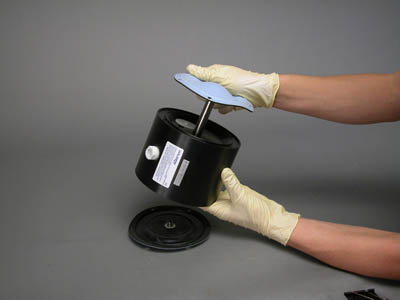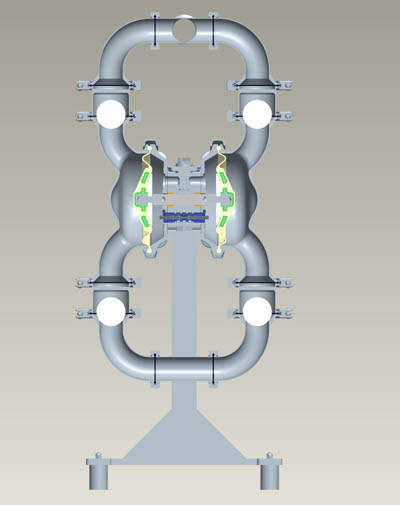Air operated double diaphragm (AODD) technology has many benefits for biopharmaceutical processes. Axflow explains how it works and highlights some applications
Over the past half-century the Air Operated Double Diaphragm (AODD) pump has evolved into a unique solution for the complex fluid transfer needs encountered within the biopharmaceuticals industry. Because of the critical nature of some processes, inefficient product transfer methods such as manual rolling carts with containers, purging tanks to evacuate product or manual gravity feeding transfers, have been common. However, purpose-designed AODD pumps for this industry now allow further use of pumped transfer processes (and associated production and energy efficiency) approaching the degree already encountered in the general chemical and industrial sectors (see Figure 1).
The diaphragm concept is already well known in the biopharmaceuticals industry as a result of the widespread employment of diaphragm valves. The diaphragm valve has long been the valve of choice because of its high product containment and easy cleaning traits. These are also available with the AODD pump, together with a seal-less stem and shaft-free product-side environment.
This is important, as both the diaphragm valve and diaphragm pump have less risk of producing damaging shear and neither technology has dynamic seals, which are potential points of leakage that could lead to contamination of the product and environment. With the innovations and enhancements for the ultra-sanitary conditions needed by the pharmaceutical industry, the diaphragm pump is now an attractive option for many fluid transfer duties. These processes – and the products they produce – must meet a wide array of regulations and certifications to ensure that they are being performed in a high purity environment. Among the regulations that AODD pumps can satisfy are EHEDG, 3A, CE, ATEX, USP Class VI and FDA CFR 21.177. This includes a validation package with mill, 3.1b. polish, passivation and classified area use certification.
The nature of the liquids can run the gamut from extremely shear-sensitive to highly viscous, and semi-solids can range from liquid glucose to polymer slurries. Pharmaceutical and biochemical fluids currently pumped by AODD pumps include: blood and by-products, live cell cultures (see Figure 2) and vaccine producing solutions, egg emulsions for vaccine production, pill coatings, eye care solutions, fluids for oncology, specialised disinfectants, nutriceuticals, vitamins, topical (creams and lotions), and filter media. The employment of AODD technology can guarantee safe transfer during the production process.
Regardless of the method used to produce biopharmaceuticals, the actual manufacturing process is precise and must be performed under demanding, exacting conditions often in a cleanroom environment that prohibits instances of product leakage, fouling or cross-contamination.
AODD pump technology offers the biopharmaceutical manufacturer a number of benefits in many crucial areas:
- Sterile product transfer – AODD pumps remove the need for gas-purge systems in continuous processes because the technology allows both the filling and emptying processes to occur at the same time, while keeping the product contained and pure.
- Process flexibility – AODD pumps can accommodate highly variable process conditions found in many hygienic conditions.
- Sampling – complex pharmaceutical processes under strict conditions require frequent and multi-point sampling. AODD pumps provide the ability to extract samples while maintaining a high degree of containment and avoiding cross-contamination.
- Clean in Place (CIP) – the AODD pump’s self-priming, dry-running and seal-less design is ideal for CIP operations.
- Chemical feed – this is a traditional role for AODD pumps as their seal-less design and reliable product containment ensure safety when handling volatile or potent chemicals.
- Ingredient unloading – because they self-prime, run dry and have negative suction lift, AODD pumps meet pharmaceutical validation requirements and can be applied where needed.
- Product recovery and semi-solids removal – again, the AODD pump’s dry-run, self-priming and full product containment makes it ideal for use in most filtering or separation processes.
- Chromatography, separation, purification and filter feed – these processes often require shear-sensitive transfer and constant pressure feed - traits that are found in AODD pumps.
- Extracting delicate cell structures from centrifuge discharge provides a good example of the role for the AODD pump.
Cleaning and maintaining this type of pump is very simple, having been designed for easy disassembly. In their highest hygienic configurations AODD pumps are designed for CIP cleaning, thereby eliminating manual labour and contamination risks.
optimising operations
As biopharmaceutical processes evolve, more attention is being given to optimising plant and operations. The separation of mechanical and utility functions is an example of area/floor space optimisation. AODD pumps can be split so that the ‘power side’ is largely located remotely in an unclassified area, and the fluid end can be placed in a classified area with only an air supply line connecting the two. This means that motors, oil filled gear cases and greased bearings no longer need to be located in the clean area, raising the level of hygiene and minimising the risk of product contamination.
For high purity industries, one major innovation that has made this pump one of the most viable propositions has been the integral piston diaphragm (IPD).

Fig. 3: Integral piston diaphragms are featured in certain AODD pumps
Unlike traditional pump diaphragms that have an outer plate that supports the diaphragm and is more difficult to clean, as well as being a potential leak point, the IPD (see Figure 3) is completely laminated with USP Class V1 PTFE on the product side. This endows the highest degree of containment and ensures the pump is easy to clean.

Fig. 4: Inside an AODD pump
| The workings of an AODD pump |
| The uncomplicated design of AODD pumps features few moving parts, and those that do move have simple and specific tasks (see Figure 4). |
| Air chamber – this houses the air that powers the diaphragms. |
| Air distribution system – the driver of the pump, it is the mechanism that shifts the pump to create suction and discharge strokes. |
| Outer diaphragm piston – connects the diaphragms to the reciprocating common shaft and seals the liquid section from the air section of the diaphragm. |
| Inner diaphragm piston – located on the air section of the pump, this does not come into contact with the process fluid. |
| Valve ball – seals and releases on the check-valve seats, allowing the discharge and suction of the process liquids to occur. |
| Valve seat – provides the place in which the ball valves can check and create a suction lift |
| Discharge manifold – allows fluid to discharge from the pump through the port, which is typically located at the top of the pump. |
| Liquid chamber – this is separated from the compressed air by the diaphragms, during the suction stroke it fills with process fluid and is emptied during the discharge stroke. |
| Diaphragm – acts as a separation membrane between the process fluid and the compressed air that is the driving force of the pump. To give the performance required, diaphragms must be of sufficient thickness and of an appropriate material to prevent degradation or permeation in specific process fluid applications. |
| Inlet manifold – this is where fluid enters the pump through the intake port located at the bottom of the pump. |




